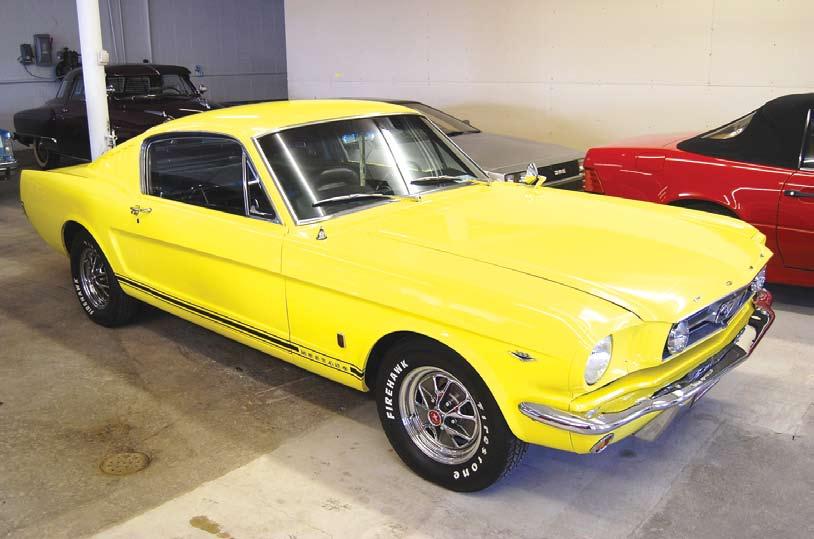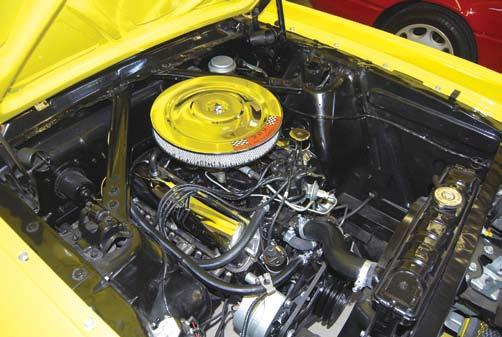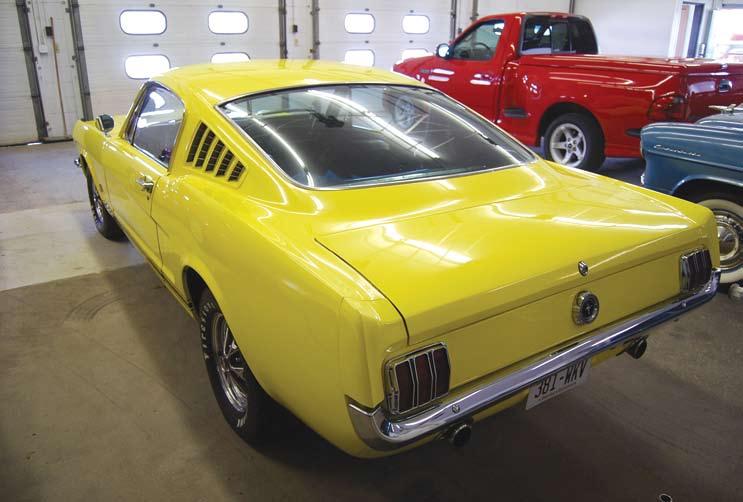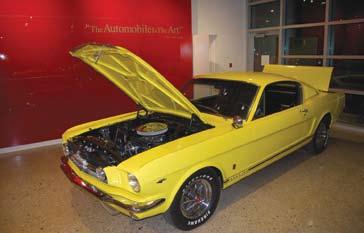
6 minute read
1965 Ford Mustang GT
Fast Ford Fun ’65 Mustang GT
Story and photos by John Gunnell
Advertisement
My first and only ride in a Mustang took place in the car you see on these pages. It was on October 15, 2015. At that time, a fascinating man named William “Red” Lewis was just getting started on creating a place called The Automobile Gallery (www.theautomobilegallery.org) in Green Bay, Wis. It was what most people would think of as a car museum and what Red thought of as an art gallery featuring cars. Like an art gallery curator, Red Lewis had two things foremost in mind for The Automobile Gallery. First, he wanted it to tell the history of the automobile from the early 1900s to the current day. Second, he wanted the cars he put in the Gallery to be colourful and exciting. This bright yellow 1965 Mustang GT fit both criteria—plus it was fun to drive.

Red made the rip from his home in De Pere to the Gallery in downtown Green Bay behind the wheel of a black 1959 Buick hardtop. He had six ’59 Buicks and he loved driving them. He had me follow him in the yellow Mustang fastback, which had the high-performance 289-cid V8 and a four-speed gearbox. If Red was happy driving that big Buick cruiser, I was twice as happy behind the wheel of the stickshift Mustang 2+2.
Though it was far from the fastest ‘60s car, the Mustang GT was a snappy ride and a model that played a big role in building enthusiasm for muscle cars. It’s a model that very rarely gets credit for its contribution to muscle car history. As Car Life magazine put it, “Ford started a round-up of its state-of-the-Total-Performance art to produce the Mustang GT.” Before getting into the go-fast details, let’s review Mustang history a bit.
It is not often that a car comes along and gets to create its own market segment, but that’s exactly what took place when Ford introduced the Mustang. This sporty



The dragster on the wall was part of the Gallery’s decorations. compact took its bow at the New York World’s Fair on April 17, 1964. The Mustang started an all-new “pony car” segment and the market for such a car was large and long lasting.

There is argument among purists over whether the Mustangs produced prior to September 1964 are 1964 1/2 or 1965 models. However, when it comes to the interesting and collectible GT equipment group, there can be no question about its dating. It was initially released for the first anniversary of the Mustang’s introduction on April 17, 1965.
The Mustang had already become a desirable commodity. Its standard equipment included bucket seats. It had the very popular long hood/short deck look. At first, it came as a sport coupe (two-door hardtop) and a sportylooking convertible. In the fall of 1964, a two-door fastback coupe model that was officially called 2+2 was added to the line.
From the Mustang’s outset, a lengthy list of optional equipment was important in Mustang marketing plans. Ford could introduce the base model with a low price, but buyers could then add lots of appearance and convenience items, plus some bolt-on high-perfor-



Note the wood-grained steering wheel and GT instrumentation.
The black Buick was on the lift and Red was ready to position the Mustang below it. An old closed-up circa-1958 Cadillac dealership was being remodelled into The Automobile Gallery.
CHALLENGER 289 FOUR-BARREL ENGINE Overhead valves. Cast iron block. Displacement: 289 cid. Bore and stroke: 4.00 x 2.87 inches. Compression ratio: 10.0:1. Brake hp: 225 at 4,800 rpm. Torque: 305 at 3,200 rpm. Five main bearings. Hydraulic valve lifters. Carburetor: Four-barrel. Cooling system capacity: 16 qt. with heater. Crankcase capacity: 4 qt. (add 1 qt. with new filter). Code A.

CHALLENGER 289 HIGH-PERFORMANCE FOUR-BARREL NGINE Overhead valves. Cast iron block. Displacement: 289 cid. Bore and stroke: 4.00 x 2.87 inches. Compression ratio: 10.5:1. Brake hp: 271 at 6,000 rpm. Torque: 312 at 3,400 rpm. Five main bearings. Solid valve lifters. Carburetor: Four-barrel. Cooling system capacity: 16 qt. with heater. Crankcase capacity: 4 qt. (add 1 qt. with new oil filter). Code K.
MUSTANG GT BASIC DIMENSIONS Wheelbase: 108 inches. Overall length: 181.6 inches.
MUSTANG GT TIRE EQUIPMENT High-performance 289 V-8: 7.00 x 14 four-ply tubeless black sidewall.
MUSTANG GT OPTIONS Accent Group ($14.20). Ford air conditioner ($283.20). Heavy-duty battery ($7.60). Full-length centre console ($51.50). Console for use with air conditioner ($32.20). Equa-Lock limited-slip differential ($42.50). California-type closed emissions system ($5.30). Challenger four-barrel 225-hp V8 ($162). Challenger 271-hp hi-po V8 w/Special Handling Pkg and 6.95 x 14 nylon tires ($442.60). Emergency flashers ($19.60). Tinted glass with banded windshield ($30.90). Tinted-banded windshield glass ($21.55). Back-up lights ($10.70). Power steering ($86.30). Push-button radio with antenna ($58.50). Deluxe retractable front seat safety belts ($7.55). Special Handling package, with 225-hp V8 ($31.30). Padded sun visors ($5.70). Cruise-O-Matic transmission with 225-hp V8 ($189.60). Four-speed manual transmission with V8 ($188). Visibility Group ($36). Wheel covers with knock-off hubs ($18.20). Fourteen-inch wire wheel covers ($45.80). Fourteen-inch styled steel wheels ($122.30).

mance hardware, and increase Ford profits. This marketing program worked well.
Combining available mechanical features with new visual pieces made the mid-1965 GT package a fairly thorough upgrade. First, the buyer had to order one of two optional high-performance engine packages, which at the time meant either the 225-hp Challenger Special 289 V8 at $157, or the high-performance 271-hp 289-cid V8 for $430.
GT extras also included quick-ratio steering, front disc brakes, chrome dual exhaust tips exiting through the rear valance panel, a grille bar with built-in fog lights and GT instrumentation (replacing the Falcon-based instrument panel with five round dials.) Throw in GT badging and lower body striping and you had a bargain for around $150. Although the exact number of Mustangs built with GT equipment is not available, they had a massive following and the installation rate for this option increased even more when Ford later released the appearance items separately for dealer installation.
Red Lewis purchased his yellow 1965 Mustang GT 2+2 at Dana Mecum’s 2014 Kissimmee, Fla., auction. This car featured the performance-version 289-cid V8 with a four--barrel carburetor; a four-speed manual transmission, and Rally wheels. It was
custom-painted bright Yellow with Black GT stripes and had a new, reproduction black interior. The car—which was originally from Louisiana--had a highly-detailed chassis and engine compartment and a trumpet-style dual exhaust system. But I wasn’t thinking of any of this as we pulled into the Gallery parking lot. I was just amazed at how much fun it was to drive the four-speed Mustang there. What a cool ride!







